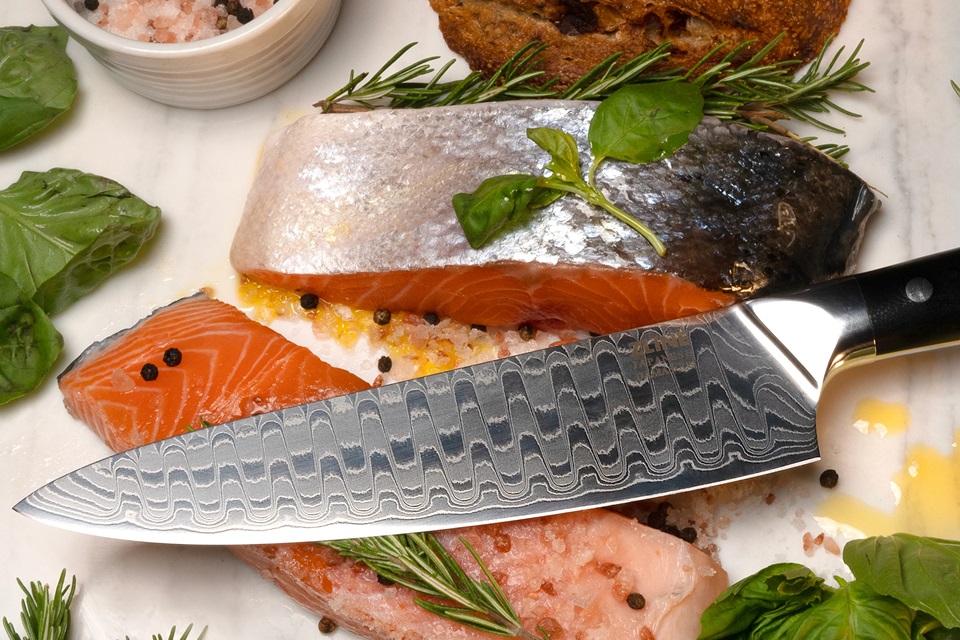Table of Contents
Cooking goes far beyond merely preparing food to eat; it is a reflection of culture, heritage, and craftsmanship. Among numerous cooking tools available to a chef, knives hold primary importance, making the choice of a perfect knife significant. Damascus chef knives are not just cooking utensils, but a major component in the narrative of Japanese culinary culture. Its relevance can be found in the precision, performance, and profound aesthetics that Damascus steel brings. The purpose of this article is to explore the centuries-old legacy of Damascus chef knives and their utmost significance in Japanese cuisine. Damascus steel originates from ancient techniques, known for its sturdiness, resilience, and distinctive patterns, and is now a highly respected material in culinary tools, particularly in Japanese cooking.
The Legacy Behind Damascus Steel
While exact dates elude historians, it is believed that the knowledge of forging a Damascus knife originated from India around 300 BC, eventually reaching Damascus, a city in Syria, where the steel gained its famous name. The “wootz” steel ingots from India were transformed into swords and knives celebrated across civilizations for their remarkable strength, sharpness, and wavy surface patterns, embodying traits that no other steel possessed.
Contrary to standard steel types, Damascus steel stands out due to its phenomenal characteristics. Composed of numerous layers of steel, a Damascus chef knife offers intriguing ‘water’ or ‘wave’ patterns, symbolic of its complex forging process. This artistry, coupled with resilience, exceptional toughness, and unparalleled edge retention, makes Damascus steel elite. The balance of hardness and flexibility of Damascus steel ensures that the knife remains sharp for longer periods while resisting the usual wear and tear, thus enhancing the overall culinary experience in the kitchen, especially in the detailed-focused Japanese cuisine.
The Imprint Of Damascus Chef Knives In Japanese Cuisine
Damascus steel initially captured the attention of the Japanese for their swords. However, the end of the samurai era gave these master smiths an opportunity to transfer these skills to kitchen knives, where Damascus steel once again proved its potential. The Japanese craftsmen admirably adopted, adapted, and refined the classic Damascus technique to create kitchen knives that have grown today to be integral components of their cuisine. This led to the production of various types of Damascus kitchen knives, each tailored to assist in the preparation of different Japanese dishes accurately.
The Damascus chef knife has significantly influenced Japanese culinary techniques. Its sharpness and precision contributed to the inception of unique food preparation methods like “Katsuramuki,” where a vegetable is peeled into a thin sheet. Prominent Japanese chefs often express their respect for these knives. As per celebrated Chef Masaharu Morimoto, “Once you have a Japanese Damascus knife, you’ll wonder how you ever got along without it. It’s an extension of my hand.” This reverence reflects deeply in the rich and diverse culture of Japanese cookery.
The Artistry Behind Damascus Knives In Japan
The creation of a Damascus knife is a labor-intensive process requiring advanced skills and techniques. It begins with multiple layers of different types of steel, which are forge-welded together. This billet of metal is then repeatedly folded and hammered, amplifying the layer count to hundreds or even thousands. This multilayered composite is then carefully heated, shaped, and finally sharpened into a knife – creating a tool with unique patterns, strength, and razor-sharp edge.
The shaping of a Damascus knife in Japan is influenced greatly by ancestral wisdom and traditional practices. A significant cultural ethos of the Japanese – “Monozukuri” or the “spirit of manufacturing,” comes alive in these knives. This spirit seeks perfection at every stage of creation, from the choice of steel to the final sharpening of the blade. Today’s Japanese Damascus knives are a testament to this relentless quest for excellence, fostering a modern appeal while keeping traditional craftsmanship alive and relevant.
Ensuring The Longevity Of Damascus Knives: Care & Maintenance
Damascus knives, while durable and resilient, require conscientious care to retain their best form over the years. Always clean the knife manually with mild soap and dry promptly to prevent water stains or rust on the blade. Regular honing of the blade will help maintain its sharpness, but make sure to use a stone specifically designed for high-quality Damascus knives. It’s also advisable to store the Damascus knives separately in a knife block or sheath to prevent damage to its delicate edge.
Knife care in Japan transcends beyond the functional aspect and enters the area of cultural respect. Knives, especially quality ones like a Damascus knife, are not just seen as a tool but as an extension of the chef’s hand. Proper maintenance and care of these knives is a mark of professional respect to oneself, to the knife, and to the food being prepared. Therefore, cleaning, honing, and storing knives correctly is deeply ingrained in Japanese culinary etiquette, emphasizing their culture of mindfulness and attention to detail.
Damascus chef knives, with their rich history, exceptional properties, and timeless elegance, have become iconic symbols in Japanese cuisine. They represent not only the culinary artistry but also the inherent reverence for craftsmanship and tradition in Japan. As we continue to explore and appreciate the culinary world, the importance and influence these knives wield in our kitchen and dining experiences will remain undeniably significant.





No Comments